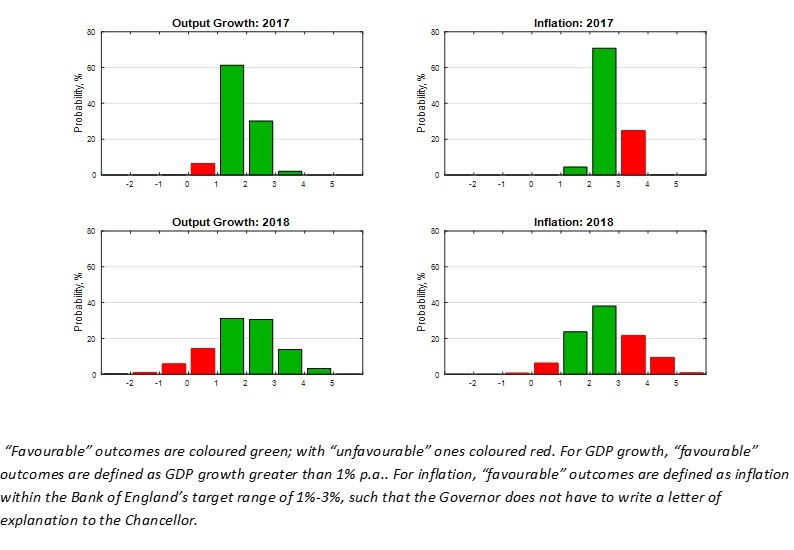WBS UK Probabilistic Forecasts, May 2017
WBS Forecasts for 2017 and 2018
WBS Forecasts for 2017 and 2018 The figure below presents WBS’s latest (as of 25th May 2017) probabilistic forecasts for real GDP growth and inflation – for 2017 and 2018 – as histograms.

Inspection of both the figure and Table 1 below reveals that economic growth of around 2% is forecast through 2017; but, relative to one quarter ago, the probability of disappointing “low” growth of less than 2% has increased from 38% to 68%. This implies that there is only a 1 in 3 chance of “strong growth” in 2017.
The prospects for growth in 2018 are considerably more uncertain, both on the upside and downside. Growth below 1% and above 3% are predicted with probability of around 20%, that is, they are equally likely.
Consistent with the depreciation of the pound since the referendum last June, inflation is predicted by the WBS forecasting system to pick up further in 2017 and 2018; relative to one quarter ago, the probability of inflation exceeding 3% in 2017 has increased from 9% to 25%. And the system forecasts a 1 in 3 chance that this high level of inflation will persist through 2018.
Table 1: Probability Event Forecasts for Annualised % Real GDP Growth and CPI Inflation
Year |
Real GDP Growth (%, p.a.) |
CPI Inflation (%, p.a.) |
||||
|
|
Prob(growth<0%) |
Prob(growth<1%) |
Prob(growth<2%) |
Prob(letter) |
Prob(CPI<1%) |
Prob(CPI>3%) |
2017 |
<1% |
7% |
68% |
25% |
<1% |
25% |
2018 |
8% |
21% |
52% |
39% |
7% |
32% |
Comparison with other forecasters
The main objective of the WBS forecasting system is to provide benchmark and judgement-free probability forecasts; and to assess the risks associated with other forecasts when these do not involve a direct communication of forecast uncertainty.
Accordingly, we take the most recent forecasts from the Bank of England and the IMF. While the Bank of England provides an explicit assessment of forecast uncertainties for the UK, via “fan charts”, the IMF provide point forecasts only.
We use the WBS forecasting system histograms to compute the probability that GDP growth or inflation is greater than the other forecaster’s “point” forecast. If the point forecast from the other forecaster falls in the centre of the WBS forecast distribution we would expect this probability to be 50%. On the other hand, if the forecaster is more optimistic (pessimistic) than we suggest they should have a probability less (greater) than 50%.
Table 2: Forecast Comparison for 2017
|
|
Real GDP Growth (%, p.a.) |
CPI Inflation (%, p.a.) |
||
|
|
Point Forecast |
Prob. of a higher outturn |
Point Forecast |
Prob. of a higher outturn |
Bank of England[1] |
1.82 |
0.49 |
2.57 |
0.62 |
IMF |
2.00 |
0.32 |
2.50 |
0.67 |
Table 3: Forecast Comparison for 2018
|
|
Real GDP Growth (%, p.a.) |
CPI Inflation (%, p.a.) |
||
|
|
Point Forecast |
Prob. of a higher outturn |
Point Forecast |
Prob. of a higher outturn |
Bank of England1 |
1.72 |
0.58 |
2.50 |
0.51 |
IMF |
1.50 |
0.64 |
2.60 |
0.47 |
Looking at GDP growth, Table 2 shows that both the Bank of England and IMF increasingly agree with the WBSFS that growth in 2017 will likely not seriously disappoint. Since Brexit, the Bank of England and IMF have revised up their GDP growth forecasts for 2017 towards the higher values the WBSFS has been consistently predicting. While these forecasters do remain slightly more pessimistic about GDP growth in 2018 than the WBSFS, the gap has narrowed in the last couple of quarters. This is consistent with the view that Brexit has yet to disrupt historical relationships between macroeconomic variables; and accordingly Bank of England and IMF central forecasts are more-in-line with the judgement-free forecasts produced by the WBSFS.
Tables 2 and 3 also reveal how the Bank of England and IMF inflation forecasts for 2017, and particularly 2018, are increasingly in-line with those of the WBSFS, following upward revisions to the inflation forecasts from the WBSFS. The WBSFS now predicts a 1 in 3 chance that inflation will above 2% in 2017 instead of the smaller 1 in 5 chance one quarter ago.
Note on the Warwick Business School Forecasting System
The Warwick Business School Forecasting System communicates forecast uncertainties for UK GDP growth and inflation in an open and transparent way – free from judgement. The system involves consideration of a range of cutting-edge econometric forecasting models, as opposed to relying on a single model which is likely misspecified.
Focus is on the production and publication of accurate probabilistic forecasts, using statistical methods, rather than constructing a narrative or story around one particular, but likely far from certain, possible set of outturns.
The WBS forecasts thus emphasise forecast uncertainties; and provide a benchmark against which one can assess the plausibility of other forecasts.
[1] The Bank of England (mean) forecasts for calendar year inflation are derived from their published forecasts for the four-quarter inflation rate and are, therefore, to be treated as approximate.
